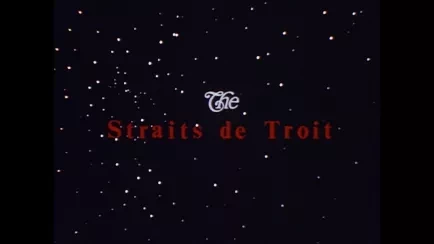Film, Motion Picture
The Straits de Troit
Color 16mm reel containing "The Straits de Troit," a documentary on the Detroit River made by Wayne State University student Robert C. Kreipke. The film includes segments on freighters, the U.S. Coast Guard, the mail boat J.W. WESTCOTT II, the fire tug JOHN KENDALL, hydroplane racing, and pollution.
The film opens with scenes of a model of the Earth rotating in space, and red tinted footage of volcanic activity and water over which the narrators discuss the planet's geological history, and the formation of the Great Lakes due to glacial activity.
Next, over footage taken form a boat in a wooded area, the narrators discuss the Detroit River before the arrival of Cadillac. The early history of Detroit from the time of its founding is then covered, supplemented by a series of still of historical illustrations and paintings, and a map showing the locations of ribbon farms.
When the narrators reach the era of the steamship in the region, the film features a series of sepia-toned clips including PUT-IN-BAY boarding for a "Rotary Clubs Children's Excursion" according a banner draped on the side of the boat, a crowd at a dock, and larger passenger ship leaving port. This segment includes contemporary footage of a freighter backed by the city's skyline, a man sitting on a riverfront behind Cobo Hall, and a montage of historical photos and archival items connected to the history of passengers and excursion ships on the Detroit River.
The film then highlights the Boblo boats as the only major surviving excursion line. This section includes footage of Captain Boblo at the Detroit dock, and the COLUMBIA boarding and leaving dock.
Following a series of shots of people watching passing boats from Belle Isle, the film transitions to focus on industry connected to the Detroit River. The section of freighters and the shipping industry in accompanied by shots of the Nipigon Transport, Limited freighter LAKE WINNIPEG, and a crane ship backed by the downtown skyline.
Next the film focuses on the role of the U.S. Coast Guard on the Detroit River and the function of buoys, accompanied by exterior shots of the Belle Isle Coast Guard Station, the buoy tender BRAMBLE (WLB-392), a stack of buoys at the station's dock, and of the exterior of the old Detroit Lighthouse Depot at Mt. Elliott Street and Wight Street. Next the film covers in detail the operation of the U.S. Postal Service on the river through the mail boat J.W. WESTCOTT II. The WESTCOTT is shown delivering mail an unidentified laker, in a wide shot, then the camera follows the workers as the move from the boat's office, disembark on the WESTCOTT, and bring a pilot and mail delivery to the Canadian Steamship Lines freighter COVERDALE.
Next, the film moves next door to the WESTCOTT's dock to focus on the Detroit Fire Department's firetug JOHN KENDALL. The camera tours the deck of the KENDALL to show the hose fittings, the cabinet of different hose nozzles, and one of the guns. The crew of the boat is then filmed as they go through the procedure to disembark from dock for a demonstration run, including the operation of its steam engine. Once the boat reaches the middle of the river, the gun is sprayed directly upward.
The next segment of the film concerns the Detroit River's railroad ferries. This segment begins with a wide shot of ferries pushing barges loaded with rail cars, and several shots of rail road cars in a freight yard. Shots follow of the tug R.G. CASSIDY with a barge,
Pleasure craft are the focus of the film's next section. This section features footage of a cabin cruisers and sailboats on the river, a boat sales and rental business, the exteriors of the Detroit Boat Club and Detroit Yacht Club, several views of activity at Kean's Marina, the sign for Sindbad's, and the exterior of the Roostertail.
The film then transitions to the topic of the history of powerboat racing on the Detroit River, with an emphasis on Gar Wood, using historical footage of Wood's MISS AMERICA VI on Lake St. Clair taken from a 1928 Detroit News Pictorial newsreel (included in full on reel 2015.011.022). Contemporary footage of the 1971 Horace Dodge Cup Race follows, including shots of the MISS BUDWEISER, ATLAS VAN LINES, MISS MADISON, TOWNE CLUB, HALLMARK HOMES, NOTRE DAME and PAY'N PAK racing, as well as activity in the pits, crowds, a Coast Guard helicopter landing in the river.
Next, the film focuses on the International Freedom Festival. Footage of the fireworks display as well as brief shots of the riverfront and of the crowd earlier in the day are included.
Pollution and ecological concerns take the spotlight in the penultimate section of the film. This section includes shots representing everyday day water usage (a man watering a garden, a faucet, the fire hydrant on the west corner of Putnam Street and Woodward Avenue, as well as footage representing pollution (aerial shots of Zug Island, "No Swimming, Polluted" and "Fish at Your Own Risk, Pollution" signs on Belle Isle, as well as garbage floating in the river.
The film's conclusion features a montage of shots of the riverfront and related things including the sculpture "Spirit of Transportation," the exterior of Mariners' Church, the ventilation building above the Detroit end of the Detroit-Windsor Tunnel, the MacArthur Bridge, ducks, a sailboat near Kean's Marina, the N.M. Paterson and Sons freighter PATERSON, the tug B.H. BECKER at dock, the Belle Isle water treatment intake building, Waterworks Park, a geared ocean-going freighter, and a sunset over the river.
The film ends with a credits sequence consisting of tinted monochromatic stills.
The film is housed within a grey metal tin with a Dossin mailing label. The canister is marked "Detroit River Good Copy."
Request Image

